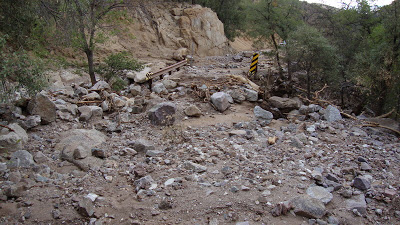Solastalgia
Today the late-afternoon sun in Phoenix is casting a sickly, yellow pall over the city. It's due to smoke from a wildfire sixty miles to the east of downtown Phoenix, which as of this writing has consumed 123,000 acres of high desert, oak and juniper woodland, and Ponderosa pine forest.
Human-caused, as most Arizona wildfires are.
Last year another human-caused wildfire rolled across 193,000 acres of similar terrain, doing particularly grievous damage to stands of mature saguaro cacti, Arizona's most iconic plant. Most will not recover.
Arizona's Upland Sonoran Desert, noted for its saguaros, cholla cactus, prickly-pears, and palo verde, mesquite, and ironwood trees, and many other species, is not adapted to fire. The desert did not burn until humans introduced non-native grasses to improve the conditions for cattle grazing, with the unintended side effect of providing an excellent medium for wildfire ignition and growth.
After fire, this landscape does not regenerate. It is replaced by a grass-dominated landscape novel to Arizona. Wherever fire burns, the Upland Sonoran Desert is gone forever.
The woodlands at higher elevations were not only adapted to lightning-started wildfire but thrived on it. Early forest policy, in response to the fires of the "The Big Burn" in the U.S. West in 1910, called for suppression of all woodland blazes as quickly as possible.
The story is now familiar to Americans who pay attention to the forests. Fuels build up in the woodlands. Low-intensity fires, which once cleaned up the forest floor, suppressed the growth of shrubs and small trees, and cycled nutrients back into the soil, have been absent. Heavy fuel loads now combine with hotter and drier weather and human ignition to create unnatural fires of colossal size and intensity.
Ponderosa pine reseeds slowly from the margins of burned areas, and closing the wound may take many decades or even centuries. And a hotter climate may make pine regeneration all but impossible.
These fires have cleared entire Arizona mountain ranges of their trees, something that, thirty years ago, I would not have thought possible. The roll of losses is staggering and depressing: The forests of the Santa Catalinas and the Chiricahuas -- mostly gone. The isolated stands along the top of the Mazatzals -- gone.
And last night and tonight the pretty forest atop the Pinal Mountains south of Globe is going up in smoke.
Elsewhere the Santa Ritas, the Pinaleños, and the Sierra Ancha have all been touched by flame, in places severely. The gems that were Escudilla Mountain and the eastern White Mountains -- gone or reduced to relict stands. Much of the forest of the eastern Mogollon Rim country -- gone.
I cannot now hike anywhere in Arizona, in remaining unburned terrain, without thinking that the landscape is temporary and fated for destruction. It's when and not if. The joy I take in the landscape is now shaded by elegy.
This uniquely beautiful and biologically diverse landscape has also seen a catastrophic increase in human impact. In my lifetime Arizona has grown from 1.3 million residents to well over 7 million. Outdoor recreation takes a heavy toll. Outdoor recreationists start fires.
This afternoon's yellow sky made me think that I am seeing the future, one of unnatural heat and fire, of dry mountain rivers, of relict stands of pines and saguaros: Degradation everywhere.
Not long ago I encountered a word that means the homesickness you feel when you are still at home but your home has changed beyond recognition. Your homesickness is for a world lost.
A little searching and I found it again: Solastalgia. It is a coinage by environmental sciences professor Glenn Albrecht, derived from Latin solacium (comfort) and Greek algia (pain) -- pain from the loss of solace.
I no longer recognize Arizona. It is a world irrecoverably lost.








